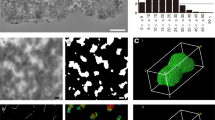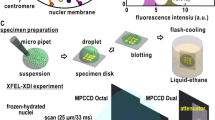Abstract
ELECTRON microscope observations1–5 on sections of chromosomes from various species reveal granules and threads of width ranging from about 20 to several hundred angstroms. Chromosomes disrupt on an air–water interface6 into longer threads about 200–250 Å wide7–9. Our observations on sections of erythrocytes from chicken and lamprey reveal a regular structure within the condensed chromatin (heterochromatin) closely adjacent to the inner membrane of the nuclear envelope. To help in the elucidation of these structures, the sections were tilted in the electron microscope. The resulting data demonstrate, not unexpectedly, the importance of superposition effects in determining nuclear images.
This is a preview of subscription content, access via your institution
Access options
Subscribe to this journal
Receive 51 print issues and online access
$199.00 per year
only $3.90 per issue
Buy this article
- Purchase on Springer Link
- Instant access to full article PDF
Prices may be subject to local taxes which are calculated during checkout
Similar content being viewed by others
References
Goodman, R. H., and Spiro, D., Exp. Cell Res., 27, 359 (1962).
Hay, E. D., and Revel, J. P., J. Cell Biol., 16, 29 (1963).
Hyde, B. B., in The Nucleohistones (edit. by Bonner, J., and Ts'o, P.), 163 (Holden Day Inc., San Francisco, 1964).
Ris, H., and Chandler, B. L., Cold Spr. Harb. Symp., 28, 1 (1963).
Moses, M. J., and Coleman, J. R., in The Role of Chromosomes in Development (edit. by Locke, M.), 11 (Academic Press, New York, 1964).
Kleinschmidt, A. K., Lang, D., Jacherts, D., and Zahn, R. K., Biochim. Biophys. Acta, 61, 857 (1962).
Ris, H., Proc. Roy. Soc., B, 164, 246 (1966).
Wolfe, S. L., J. Ultrastruct. Res., 12, 104 (1965).
DuPraw, E. J., Nature, 206, 338 (1965).
Davies, H. G., and Tooze, J., J. Cell Sci., 1, 331 (1966).
Bruni, C., and Porter, K. R., Amer. J. Path., 46, 691 (1965).
Farquhar, M. G., and Palade, G. E., J. Cell Biol., 13, 55 (1962).
Dales, S., J. Cell Biol., 13, 303 (1962).
Frasca, J. M., and Parks, V. R., J. Cell Biol., 25, 157 (1965).
Palade, G. E., J. Exp. Med., 95, 285 (1952).
Sabatini, D. D., Bensch, K., and Barrnett, R. J., J. Cell Biol., 17, 19 (1963).
Fawcett, D. W., Amer. J. Anat., 119, 129 (1966).
Author information
Authors and Affiliations
Rights and permissions
About this article
Cite this article
DAVIES, H. Fine Structure of Heterochromatin in Certain Cell Nuclei. Nature 214, 208–210 (1967). https://doi.org/10.1038/214208a0
Received:
Issue Date:
DOI: https://doi.org/10.1038/214208a0
This article is cited by
-
Mobility of multi-subunit complexes in the nucleus: accessibility and dynamics of chromatin subcompartments
Histochemistry and Cell Biology (2005)
-
Freeze-fracture morphology of nuclear pockets
Virchows Archiv B Cell Pathology Including Molecular Pathology (1991)
-
Superchromosomal organization and its cytogenetic consequences in the Eukaryota
Genetica (1978)
-
Supercoiled DNA folded by non-histone proteins in cultured mammalian cells
Nature (1975)
-
Coiled Supercoiled DNA in Critical Point Dried and Thin Sectioned Human Chromosome Fibres
Nature New Biology (1971)
Comments
By submitting a comment you agree to abide by our Terms and Community Guidelines. If you find something abusive or that does not comply with our terms or guidelines please flag it as inappropriate.



